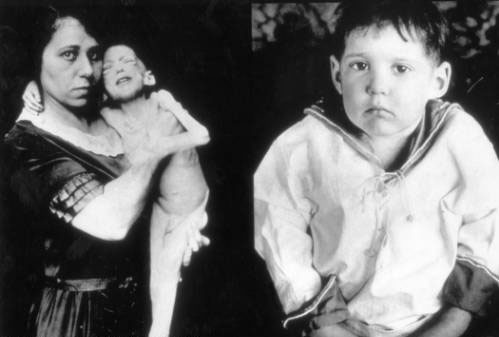
Patient before (left) and two months after (right) insulin. Ca 1920s. With the introduction of insulin, Eli Lilly and Company prepared an extensive literature program to provide practicing physicians with useful guidelines on dosage determination, suitable potencies, dietary measures, and urine and blood analyses. A variety of accessories for patients with diabetes were also produced. With the collaborative development of insulin, the battle against diabetic coma ended. Digital Image 2010 Eli Lilly and Company. All Rights Reserved.
Eli Lilly and Company and Indianapolis have been at the center of insulin production and innovations in diabetes care since immediately after the hormone was discovered in 1922
Indianapolis became a leading center for insulin manufacture in 1922, immediately after the hormone’s discovery at the University of Toronto (Canada). Insulin is secreted in the pancreas and essential to the metabolism of carbohydrates and fats. Insulin deficiency leads to the development of diabetes. Many diabetics require regular injections of insulin to maintain life and health.
When the Canadians had difficulty making more than small laboratory batches of the hormone, they accepted an offer of collaboration from George H. A. Clowes, the research director of Eli Lilly and Company. Under a formal agreement signed in May 1922, Lilly and the University of Toronto fully shared their knowledge of insulin, with the company being given a one-year exclusive license for the US market. The focus of insulin production immediately shifted to Indianapolis. The Lilly product, Iletin, initially prepared from beef or hog pancreas, was exported to Canada and used in clinical trials that signaled a milestone in treatment for millions of diabetics.
Eli Lilly and Company subsequently made important advances in insulin isolation and purification and used its head start to dominate the US market for insulin, a position it has never relinquished. Insulin has been the most important product in the company’s history, and Lilly has continued to be a world leader in insulin research.
In 1982, Lilly introduced synthetic human insulin (Humulin), made by techniques of genetic engineering, marking another milestone in the history of science and therapeutics. In the 1990s, the company introduced Humalog, a fast-acting insulin product.
In the 21st century, Lilly has continued to put Indianapolis on the map as a leader in the production of drugs to treat diabetes. In January 2011, Lilly and Boehringer Ingelheim made an agreement to joint development and marketing of new diabetes therapies. The alliance resulted in the development of Tradjenta, a prescription drug used to lower blood sugar in adults with type 2 diabetes in combination with diet and exercise.
Since 2014, Lilly has launched Jardiance and Trulicity, both designed for the treatment of type 2 diabetes. In 2019, the FDA approved Lilly’s Nasal Glucagon to treat severe hypoglycemia. It provides a simple one-step delivery system that saves crucial time from the multistep system that it replaced, which prevents hospitalization of diabetes patients who are four years old or older in emergency situations. The company has a number of other diabetes-care products in its research and development pipeline with potential release dates of 2021-2022.
MICHAEL BLISS and ELIZABETH J. VAN ALLEN

